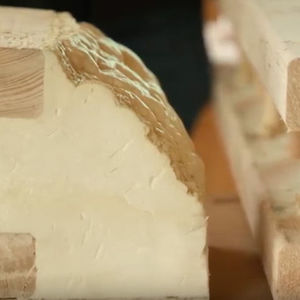
As with much of the building industry, wall framing is continually evolving. Our firm, Steven Baczek Architect, keeps an open mind when it comes to new products. For a current residential project, we are using the Tstud as a main component for the exterior wall framing. The house’s small size, simple form, and straightforward framing plan created the perfect proving ground to use the Tstud for the first time. While dimensionally similar to the common 2×6 solid stud, the Tstud provides a substantial reduction in thermal bridging, and has three times the strength a conventional 2×6 stud. Coupled with insulating exterior sheathing (R-9) and blown cavity insulation (R-29), it creates the basis for an exceptionally efficient wall frame with a whole-wall R-value of 30. The benefit of the Tstud is the cavity insulation between the stud chords, which does not exist in solid-stud framing. While the insulating sheathing does provide a thermal break, we chose to use the Tstud to further enhance the thermal break of the wall assembly in its entirety.
Because this was our first time using the product, it was essential to thoroughly consider and review a few typical details. Both an exterior wall rough-framing plan and an elevation plan were drawn to determine the specific areas of interest. As illustrated, the Tstud has different widths for the two chords. However, the dimensions remain the same—one is oriented 90° in relation to the other. The result is that one face yields a 1-1/2-in.-wide surface (the spline), while the opposing face has a 2-1/2-in. surface (the flange). Following conversations with the framing contractor, we decided to use the flange as the exterior face of the framed wall. That size face created a better nailing surface for the exterior sheathing. The wall board subcontractor then used the spline as a recognizable dimension.
Weekly Newsletter
Get building science and energy efficiency advice, plus special offers, in your inbox.

This article is only available to GBA Prime Members
Sign up for a free trial and get instant access to this article as well as GBA’s complete library of premium articles and construction details.
Start Free TrialAlready a member? Log in















31 Comments
Very well done!!! Keep up the great work. Looking forward to a very bright future
We are thrilled to have her on board, Steve.
I am very excited for her!!! Thank you for your help
“[Deleted]”
Can you share some cost comparison? How did the t-stud material and labor costs match up against standard framing? And did your encounter any issues sourcing the t-stud?
We had no issue sourcing the T-Stud material with the help of Mark Willie. As for the cost, the material cost is more but we found the labor cost given to be the same as a one for one trade. I would suggest having a conversation with Mark Willie for more information on the project. You can find him on Instagram and LinkedIn.
This sounds like sales speak to me.
Where were the savings in labor? What do these t studs do to make them easier to install? I've read through the article a few times and don't see any labor savings mentioned, in fact, it seemed like it was a little more involved because of the blown-in insulation.
The benefits listed are that they provide thermal bridging and are stronger structurally, only vertically though. We don't need dollar amounts, just because prices change often, but it would be nice to know the percentage. For example, the t stud cost X% more than a 2x6x8, but we were able to save X% of hours on framing because of this.
It would also be nice to know if this project was sponsored in any way. I only say that because your firm is part of the build show network and I have seen Matt talk about these in the past video. My guess is this was a sponsored build like a lot of Matts's videos are. There is nothing wrong with that, but it would help clarify your position.
Joe I will try and break this down as best I can for you. In terms of savings in labor nowhere did we identify that there was a savings in labor. In fact, I believe the framer did not alter his cost at all for using the T-Studs. Nowhere did we cite the T-Stud to be easier to install. The framer found them indifferent. The blown-in insulation has nothing to do with the cost of framing as that is a different contractor. I understand that blown-in insulation costs more than batts, but blown-in insulation was always a part of this project as it is our favored method. As for material cost, we can say they were more expensive but we cannot speak about the financial dealings of our clients and builders we associate with. Our firm is part of the build show network and we contribute to it regularly to identify sound building practices, this house has already appeared in build show videos. However, that is due to the builder and the architect being contributors.
Joe, we would be happy to walk through some numbers with you. Mark is one of the least salesy guys we have on our team. If you do in fact want to learn more, give us a call - 612-290-6199.
I have to wonder about the blown insulation fill around these T-studs. Some nooks and crannies created that might have insulation voids. They (t-studs) basically rule out the use of standard batt insulation.
The web members of the T-Stud are generously placed, going to blown insulation ensures the cavity will be entirely filled. We have no concern about creating any voids at all.
There is a pre-insulated version of the T Stud, that would allow for the use of batts
Alexandra,
Thanks. This is exactly the write up about T-studs I've been hoping to see.
At the risk of boring everyone (I say the same thing every time T-studs come up on GBA), what will determine whether they achieve widespread use is probably very similar to I-joists: Competitive cost, and availability as a commodity item in lumberyards.
Edit: For areas where dense-packed wall insulation is rare, how do they work with batt insulation?
When we initially made the decision to use this, we quickly ruled out the use of batt insulation for the simple reason of the dimensional change of cavity depth, meaning the open cavity is 5.5" and the space between the chords is a couple inches. That makes it really hard to ensure you are getting a full insulation in-between the chords. My opinion is that we should use a blown insulation with this and not a batt.
Alexandra,
That makes perfect sense. I wonder though it that may prove be a third factor limiting the adoption of the system? Batts still constitute the overwhelming majority of the insulation used in walls in North America, and i don't see that changing very soon.
There is a pre-insulated version where they insulate the cavity of the T Stud allowing for the use of batts without voids. As for adoption, you and I know the building industry corners like a freight train, slow to see the light......but we will press on
T stud offers a product with insulation inbetween the spline and the flange that could make using batts a practical solution. That being said, there are a lot of issues with bat insulation and avoiding them in lieu of a dense pack or blown in is preferrable.
Joshua,
Of course - I had forgotten the insulated version!
I wasn't so much commenting on the relative virtues of the different types of wall insulation, as much as the reality that if batts are what builders use, that would create an obstacle to their adoption.
For me local availability is the biggest impediment. When I do a take-off, the framing package comes from my lumberyard. The advantage of dimensional lumber is I can use any extra interchangeably on other parts of the project on interior walls, as plates, blocking, bracing, or integrate it into the next job. If I need more, it's as close as my local hardware store. If they had a pile of T-studs that would change everything.
Thank you
The dense pack ... cellulose, mineral wool, or fiberglass? Cheers
I think any of those would work well
Alexandra or Steve,
I'm probably getting bit far into the weeds here, but if you were using the insulated version where the two parts of the stud are aligned, would you still have used dimensional lumber for the jack-studs, or another T-stud instead?
No, I don't think we would have, that being said the solid jack does provide solid wood for attachment at full depth of the wall. his can be pretty easily overcome with a little planning -Have a Happy New Year Malcolm!!
Cheers Steve. Great discussion!
Thanks Malcom - Happy New Year, always welcome your discussions.
Spot on Alex!
Love all the details--wonder where you learned how to make those clean and compelling?
With all of the exchange in the comments including your business partner, y0u can title your blogs:
"Back to Baczeks..."
or, given the juxtaposition of your work stations:
"Back-to-Back Baczeks..."
:-)
Thank you Peter! Love it!
I, for one, would back the Back-to-Back Baczeks Blog. Almost as good as the Bob Loblaw Law Blog.
Can you share a little bit about how the other trades work is impacted (or not) by the T studs? I'm curious about electricians and where they'd be able to staple the wires? I'm sure pulling wire horizontally in the wall is pretty easy.
Any pushback from the plumbers? HVAC?
The electricians were indifferent to using the T-Stud. Given this is a high performance home plumbing and HVAC is non existent in exterior wall and electrical was very limited. So in general there was no real push back in any way that we ae aware of.
Although they are designed to create a thermal break, these things must a godsend for thick exterior rigid foam. Hitting a 2.5" thick stud is much easier than hitting a 1.5" thick stud when fastening long screws.
Log in or become a member to post a comment.
Sign up Log in